Best Pruning Tools For Gardeners
Essential pruning tools for you
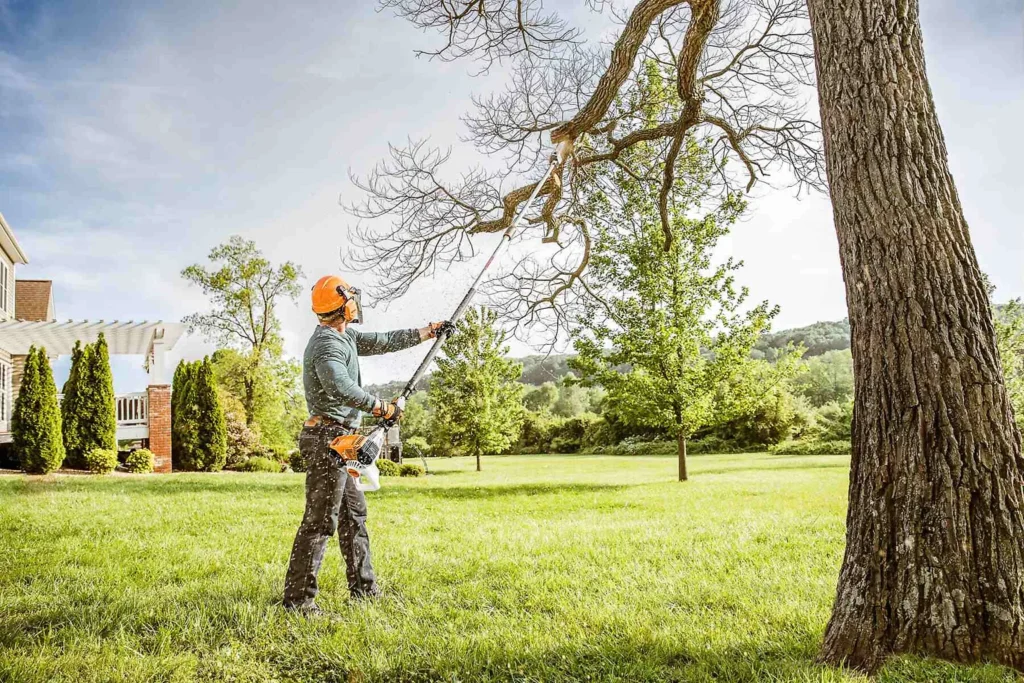
Tree Pruning tools is both art and science. It’s carefully trimming trees and plants, a practice as old as gardening. This delicate dance between humans and nature is essential for the health and beauty of our green companions. But in other to acquire a successful and satisfying pruning, you need to first consider the best pruning tools that can give you the desire result needed.
Imagine a world where every tree
was allowed to grow wild. Branches would cross and tangle, leaves would block out the sun, and the beauty of the landscape would be lost in an untamed wilderness. Pruning brings order to such cases , guiding trees to grow strong and beautiful. It’s a way to communicate to the plants, telling them how to eventually reach their full potential.
However, we’ll explore the tools that brings out the beauty and potentials of a tree. From the sharp snip of the hand pruner to the powerful cut of the saw, each tool has its role to play. We’ll learn not just about their uses, but also about the stories they tell. Each cut is a decision, a moment of connection between human and plant, a mutual journey towards growth and beauty.
Full Understanding Tree Pruning
Tree pruning is not just centered to cutting; it’s about proper care. It’s an adequate practice that nurtures trees, helping them to thrive in their environment. In under to have a concrete understanding of tree pruning, we definitely have to give a standing ovation in appreciation to the life of a tree and how our basic action and commitment can transform its beautiful story.
The Fundamental Importance of Tree Pruning:
Pruning is the gardener’s way of communicating with nature. The dialogue happens with each snip, shaping the tree’s future. When we prune, we’re not just removing branches; we’re sculpting a living entity, encouraging it to grow in health and beauty.
Why Prune?
Trees are pruned for various reasons:
1.Health: Removing diseased or damaged branches to prevent further harm.
2.Safety: Cutting away branches that could pose a risk to people or property.
3.Growth: Directing energy to desirable branches for better fruit or flower production.
4.Form: Shaping trees for aesthetic purposes or to fit within a certain space.
The Science Behind the Cut:

Every cut made during pruning can stimulate growth, slow it down, or direct it. The location and angle of the cut are crucial, as they determine how the tree will heal and where new growth will emerge. Understanding the biology of trees allows us to make informed decisions that benefit their long-term well-being, that’s the essential reason why you should consider concentrating on acquiring a good pruning tools for a better result.
Timing is Everything:
TYPES OF TREE PRUNING TOOLS
In the universe of gardening, tree pruning tools are the head heroes, the silent partners in the dance of growth and form. Each tool has its fundamental story, its purpose, and its special place in the gardener’s shed.
Let’s meet these faithful companions and learn how they help us speak the appropriate language of the trees.
Hand Pruners: The Gardener’s Companion
The Story: Hand pruners are like the gardener’s trusted friend, always ready for delicate tasks. They fit snugly in the palm, their blades sharp and precise.
Is actually one of the essential pruning tools you should consider having in your list of tools.
The Functions: Ideal for snipping small branches, deadheading flowers, and shaping shrubs. They make clean cuts that heal quickly, ensuring the tree’s health.
The Maintenance: Keep them clean, sharp, and oiled. A well-maintained pruner is a joy to use and can last a lifetime.
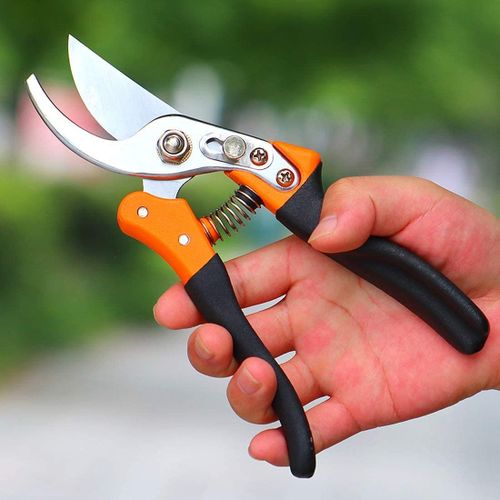
Toppers: The Lever of Strength
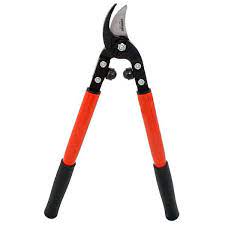
The Story: Toppers are the hand pruners’ bigger sibling, with long handles that give leverage to cut through thicker branches.
It is actually one of the best pruning tools to consider having.
The Functions: When a branch is just out of reach or too thick for hand pruners, toppers take the stage. They bring power without sacrificing precision.
The Maintenance: After each use, clean the blades and check the screws. Tighten them if necessary, and store your toppers with care.
Pruning Saws: The Sharp Solution
The Story: Pruning saws are the storytellers, each stroke removing a piece of the tree’s history, making way for new tales to grow.
When talking about pruning tools without mentioning PRUNING SAW you haven’t made your list complete yet.
The Function: For branches too thick for toppers, the pruning saw is the answer. Its serrated edge bites into the wood, making even tougher cuts possible.
The Maintenance: Always wear gloves and eye protection. Use a steady hand and let the saw do the work—no need to rush.
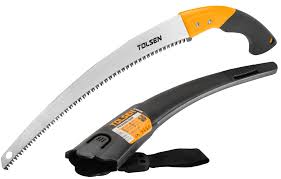
Hedge Shears: The Gardener Brush
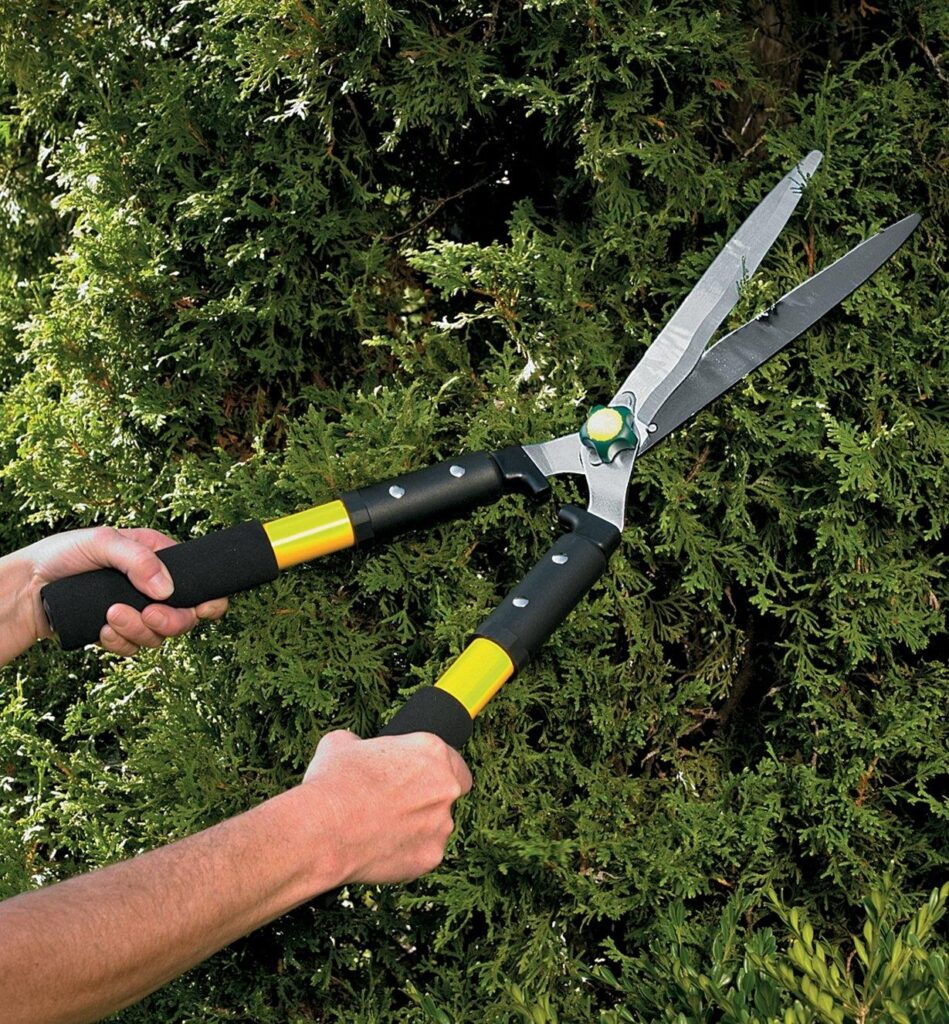
The Story: Hedge shears are the artist’s tool, turning a wild hedge into a masterpiece of green strokes. Another important pruning tool to have.
The Function: Perfect for shaping hedges and large expanses of foliage. They create straight, even lines that please the eye.
The Maintenance: Sharpen the blades regularly, and they’ll create clean cuts that are as much a pleasure to make as they are to behold.
Pole Pruners: The Gardener Lifter
The Story: Pole pruners extend the gardener’s reach, allowing them to care for branches high above without leaving the ground. When it come to pruning tools selections, don’t leave this one hanging.
The Function: They require a steady hand and a bit of practice, but once mastered, they can make high pruning safe and enjoyable.
The Maintenance: Use the pole pruner’s length to your advantage. Position yourself so that you can make a clean cut without straining.
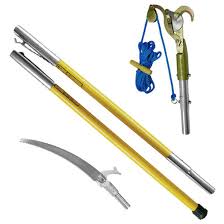
Selecting the Right Pruning Tools for the Job
In the garden of life, the right tools empower us to nurture and shape the world around us. They are the silent partners in our quest to create beauty and harmony. Choosing the right tool for pruning is like picking the right words for a heartfelt letter. It’s about finding the perfect match that conveys your intentions clearly and effectively.
Understanding the Tree’s Needs:
>The Connection: Just as every person has a unique path, every tree has individual needs. Consider the species, size, and health of the tree before making your choice.
>The Branch Size: Small branches require finesse, calling for hand pruners. Larger limbs demand the strength of toppers or saws. It all comes down to matching the right tool for the job.
The Gardener’s Intent:
>The Purpose: Are you shaping for beauty or pruning for health? Your goal will guide your tool selection, ensuring each cut serves a specific purpose.
>The Vision: Visualize the desired outcome. This foresight will help you choose the tool that can turn your vision into reality.
Ergonomics and Comfort:
>The Fit: A tool should feel like an extension of your arm. Comfortable grips and appropriate lengths reduce strain and increase control.
>The Safety: Safety can’t be overstated. The right tool not only fits the job but also protects the user. Look for non-slip handles, safety locks, and designs that keep your body away from harm.
Efficiency and Effectiveness:
>The Performance: A well-chosen tool makes the job easier and the results more satisfying. It’s about efficiency—less effort for a better outcome.
>The Quality: Invest in tools that are built to last. High-quality materials and construction mean better performance and longevity.
MAINTENANCE OF PRUNING TOOLS
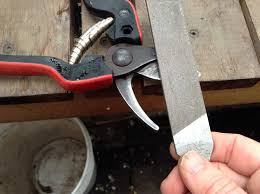
The tools we use are not just inanimate objects; they are partners in our gardening journey. Like any good partnership, the relationship we have with our pruning tools requires care and attention. We will dive in to the ways you can be able to maintain all your pruning tools to serve you for a longer period of time.
Cleanliness: The First Act of Care
>The Ritual: After each pruning session, cleaning your tools is a ritual that honors their service. Remove sap and debris to prevent rust and disease spread.
>The Method: Warm, soapy water and a stiff brush can cleanse most tools. For stubborn sap, rubbing alcohol or a specialized cleaner may be necessary.
Sharpening:
>The Precision: A sharp tool is a safe tool. It makes clean cuts that heal quickly, which is kinder to the tree and easier on your hands.
>The Practice: Sharpening can be meditative, a moment to focus as you hone the edge. Use a file or whetstone, and follow the original angle of the blade.
Oiling:
>The Shield: Oiling your tools is like giving them armor against the elements. It prevents rust and keeps the mechanisms smooth.
>The Choice: Use a light machine oil or a tool-specific lubricant. Apply a thin coat after cleaning, and before long-term storage.
Inspection:
>The Check: Regular inspection is how you spot problems before they worsen. Look for loose screws, worn handles, or damaged blades.
>The Fix: Tighten, replace, or repair parts as needed. It’s an act of stewardship, ensuring your tools are ready for the next pruning challenge.
Storage:
>The Home: Tools need a safe place to rest. A dry, organized space protects them from the weather and keeps them within easy reach.
>The Respect: Hang them up or place them in a toolbox. Show respect for their service by giving them a proper place in your shed or garage.
In caring for our tools, we are caring for ourselves and our gardens. These acts of maintenance are small stories of respect and gratitude. They are the quiet moments behind the scenes that make the more visible moments of pruning possible. Let’s cherish these tools, for they are the silent witnesses to the beauty we create in our gardens.
ADVANCED PRUNING TOOLS
As gardeners grow in their craft, they often seek out more advanced tools to tackle larger, more complex pruning tasks. These tools are the heavy lifters, the power players in the pruning world. We will look at the equipment that elevates pruning to the next level.
Hydraulic and Pneumatic Pruners: The Powerhouse
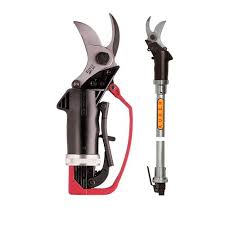
>The Force: Hydraulic and pneumatic pruners bring the might of machinery to your garden. They use fluid or air pressure to make cuts with ease, one of the best pruning tools.
>The Application: These are the go-to tools for large-scale pruning jobs or when working with particularly tough wood.
>The Consideration: While powerful, they require knowledge and care to operate safely. Always read the manual and wear protective gear.
Electric and Battery-Operated Tools: The Modern Edge
>The Convenience: Say goodbye to manual labor. Electric and battery-operated pruners offer a modern solution, combining power with portability.
>The Balance: These tools are perfect for those who need efficiency without sacrificing precision. They’re especially useful in large gardens or orchards.
>The Drawback: With power comes responsibility. Be mindful of the battery life and the need for a power source. Regular maintenance is key to keeping these tools in top shape.
Safety Equipment:
>The Protectors: When using advanced equipment, safety gear is non-negotiable. Helmets, goggles, gloves, and ear protection shield you from potential harm.
>The Investment: Quality safety equipment is an investment in your well-being. Don’t skimp on it; your safety is priceless.
The Role of Technology:
>The Innovation: Pruning technology is always advancing. Look out for tools with ergonomic designs, safety features, and smart technology that can make the job easier and safer.
>The Future: Keep an eye on the horizon for new developments. The pruning tools of tomorrow maybe even more efficient and user-friendly.
In the garden of advanced pruning, the right equipment can feel like a superpower. It amplifies our efforts, turning daunting tasks into manageable ones. As we embrace these powerful tools, let’s do so with respect for their capabilities and a commitment to safety. With advanced pruning equipment, we can shape our gardens into works of art, all while protecting the health of the trees and ourselves.
PRUNING TECHNIQUES AND BEST PRACTICES
Pruning is not just a task; it’s a craft. It’s the thoughtful care we give to our trees, ensuring they grow healthy and strong. However, we’ll share the wisdom of pruning techniques and best practices that have been passed down through generations of gardeners.

The Art of the Cut:
>Heading Back: This technique involves cutting a branch back to a bud or smaller branch to encourage bushy growth.
>Thinning Out: Removing entire branches to the trunk or main limb to improve light penetration and air movement through the canopy.
>Cleaning Up: Getting rid of dead, diseased, or damaged wood to keep the tree healthy and prevent the spread of disease.
Specialized Techniques:
>Espalier: The art of training trees to grow in flat, two-dimensional forms against walls or trellises.
>Topiary: Sculpting trees and shrubs into ornamental shapes, a practice that turns a garden into a living gallery.
>Pol larding: A method of pruning that keeps trees and shrubs at a predetermined height by cutting back the branches to the same point each year.
Best Practices for Healthy Trees:
>Right Time, Right Reason: Prune only when necessary and during the appropriate season for the specific type of tree.
>Clean Tools, Clean Cuts: Always use clean, sharp tools to make cuts that are smooth and heal quickly.
>Mind the Bark: Avoid tearing the bark when making large cuts. Apply the three-cut technique to avoid damage.
Avoiding Common Mistakes:
>Over-Pruning: Removing too much foliage can stress the tree. Never remove more than 25% of a tree’s crown in a single season.
>Flush Cutting: Leaving stubs or cutting too close to the trunk can harm the tree. Make cuts just outside the branch collar for proper healing.
>Topping: Cutting off the top of a tree can lead to weak new growth and increased susceptibility to pests and diseases.
Emotional Connection:
>Respect the Tree: Each cut affects the tree’s growth and shape for years to come. Prune with the understanding that you’re guiding a living being.
>Patience and Care: Pruning is a slow dance, a conversation with nature. Take your time and prune with intention.
PRUNING FOR SPECIAL PURPOSE
Pruning is not just a general practice; it’s tailored to the unique needs of each tree and situation. In this phase, we’ll look into pruning for specific purposes such as fruit production, ornamental shaping, and the regeneration of neglected trees.
Fruit Tree
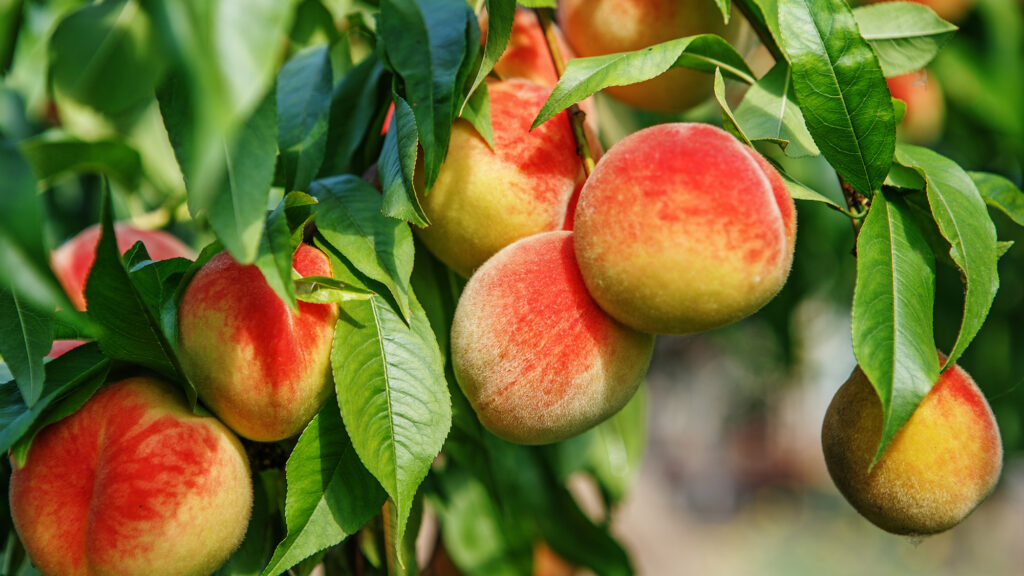
The Vision: Ornamental trees are the living sculptures of a garden, and pruning is how we shape these natural artworks.
The Approach: Selective pruning enhances the tree’s natural form, creating a stunning visual impact that complements the landscape.
The Consideration: Each cut is a thoughtful stroke, considering not just the immediate effect but the future growth and shape of the tree.
Restoration Pruning:

The Challenge: Neglected trees can become overgrown and unhealthy, but with restoration pruning, they can be brought back to life.
The Process: It’s a gradual journey, often taking several seasons. The aim is to remove deadwood, thin out crowded areas, and reestablish a strong structure.
The Reward: Watching a tree return to its former glory is a deeply satisfying experience, a testament to the resilience of nature and the care of the gardener.
Emotional Connection:
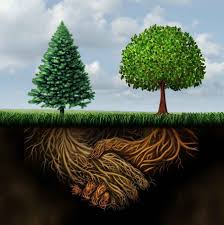
The Empathy: Pruning with a purpose goes beyond the physical act; it’s an expression of empathy for the living beings under our care.
The Satisfaction: There’s a profound sense of fulfillment in knowing that our efforts support the tree’s health and contribute to its story
Whether we’re coaxing a tree to yield a generous harvest, sculpting it into a work of art, or nursing it back to health, pruning is our way of connecting with the essence of these majestic living beings. Let us keep pruning thoughtfully and compassionately so that every tree in our gardens serves its own unique purpose.
ENVIRONMENTAL CONSIDERATION AND SUSTAINABILITY
In the gentle embrace of our gardens, every action we take echoes through the environment. Pruning, while a necessary part of horticulture, carries with it a responsibility to the broader canvas of nature.
This section is dedicated to the environmental considerations and sustainable practices that ensure our pruning enriches not just our gardens, but the world.
Eco-Friendly Pruning Practices:
Mindful Trimming: Consider the impact of each cut on the ecosystem. Encourage native wildlife by preserving habitats within the trees.
Waste Reduction: Turn pruned branches into mulch or compost rather than sending them to the landfill. This returns nutrients to the soil and reduces waste.
Sustainable Tool Choices:
Longevity Over Indispensability: Choose tools that are built to last, reducing the need for frequent replacements and the resulting environmental impact.
Eco-Materials: Seek out tools made from sustainable materials, such as recycled metal or responsibly sourced wood.
Conservation of Resources:
>Water Wisdom: Use drought-resistant plants and water-conserving methods to minimize the need for frequent pruning due to overgrowth.
>Energy Efficiency: When using power tools, opt for those with energy-saving features or consider manual alternatives that require no fuel or electricity.
Supporting Biodiversity:
>Diverse Plantings: Create a mosaic of plant species that support a variety of wildlife, promoting a balanced ecosystem.
>Pesticide Prudence: Use natural pest control methods where possible, reducing the need for chemical interventions that can harm non-target species.
Community and Education:
>Sharing Knowledge: Educate others about sustainable pruning practices. Host workshops or create guides that encourage eco-conscious gardening.
>Collaborative Efforts: Work with local conservation groups to maintain public spaces, preserving the natural beauty and ecological health of the community.
The Emotional Landscape:
>The Connection: Our bond with nature is profound. Sustainable pruning is a reflection of our respect and care for the environment.
>The Legacy: What we do today shapes the world of tomorrow. Let’s prune with the future in mind, leaving a legacy of lush greenery and vibrant ecosystems.
In conclusion, we’ve woven together the threads of sustainability and environmental stewardship. Pruning is more than a task—it’s a statement of our commitment to the planet. As we trim and shape our gardens, let’s do so with a heart full of hope for a greener, more sustainable world. With each thoughtful cut, we’re not just pruning trees; we’re nurturing the earth itself. Let’s carry this spirit forward, for in the end, we are all gardeners of this one precious planet.
Thank you for embarking on this journey with us. May your garden be a reflection of the love and care you put into every cut, choice, and minute spent among the rustling leaves.
You can always contact us for your pruning jobs and we assure you of a satisfying result. Pruning should be handled by professionals like us for a better result.
